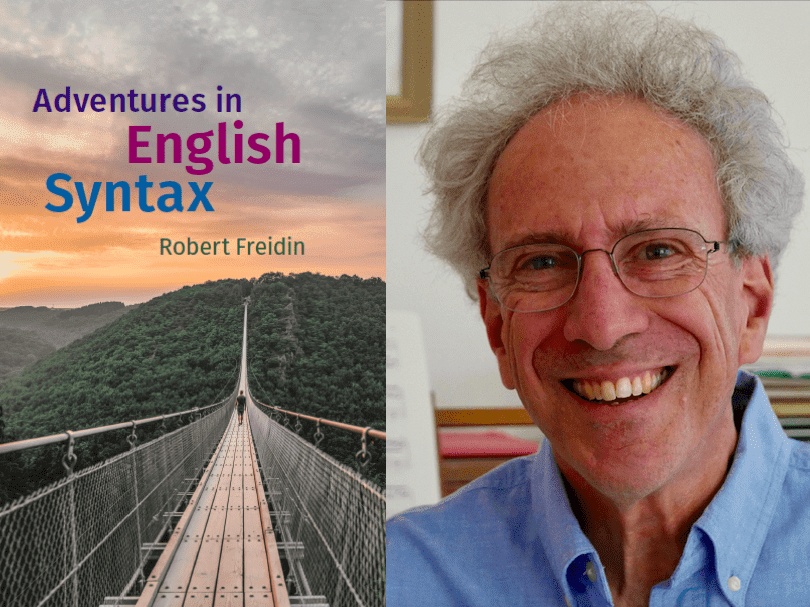Robert Freidin is Professor of Linguistics in the Humanities Council, Emeritus. His book “Adventures in English Syntax” was published by Cambridge University Press in February 2020. This retrospective Q&A is part of an effort to acknowledge all the wonderful books published early in the pandemic.
How did you get the idea for this project?
The seed for this book was planted more than 55 years ago when my 10th grade English teacher, Harriet Perl, taught us the elements of English sentence structure: prepositional phrases and relative clauses; finite vs. infinitival and gerundive clauses; compound vs. complex sentences (and thus the difference between coordination and subordination). For me, this was a revelation. My high school understanding of English sentence structure allowed me to engage with my own writing at a fundamental level where I could view my sentences as syntactic structures that connected to other syntactic structures, and thus to different sentences for expressing the same thoughts—providing a basis for comparison/evaluation. From the 10th grade on, I had an intellectual tool for crafting inevitably imperfect first drafts into prose that presented my thoughts clearly. The process of writing became a way to clarify my thinking on the topic I was writing about—what Francis Bacon had in mind when he wrote in “Of Studies” (1625) that “writing [makes] an exact man.” Externalizing thoughts in black and white is perhaps the best way to discover what is unclear, illogical, or based on questionable assumptions—if you are paying attention. And as a result, writing is never surprise-free. It ceases to be a chore, and becomes instead fun and interesting—if you enjoy exploring your thoughts and how best to express them.
What I discovered, semester after semester in more than thirty years of teaching linguistics to Princeton undergraduates, was that the overwhelming majority had no conscious understanding of English sentence structure. It had not been part of their English curriculum in high school and was not discussed in their undergraduate writing courses. Adventures in English Syntax is an attempt to change this situation by providing a more general audience with a basic understanding of English sentence structure along with a demonstration of how that understanding can be used in writing (and reading), in the hope that this might start a conversation about an essential subject that has been pretty much neglected for decades.
How has your project developed or changed throughout the research and writing process?
When I began writing this book, the plan was to start with the title of a famous Dr. Seuss book, (which is at first sight deceptively simple but turns out to be multiply ambiguous when you untether the words from the illustration on the cover) and proceed to incrementally more complex syntactic constructions—ultimately to complex sentences, questions, and finally to ellipsis. Along the way, writing each chapter turned into an unexpected adventure: discovering new connections within familiar material in syntax, and exploring new areas (like the intimate connection between punctuation and syntax, the history of prescriptive grammar, and the study of literature from the perspective of sentence structure)–hence the title of the book.
What questions for future investigation has the project sparked?
There are basically three. One I’ve wondered about for decades before I wrote this book: what is the history of the study of syntax from the beginnings of human civilization? The other two focus on the present: why is a general understanding of sentence structure, which is extremely useful for writing and reading, not part of everyone’s general education, and how might this situation be effectively changed?
Why should people read this book?
An understanding of English sentence structure is a powerful, practical, and indispensable tool for anyone who wants to become a more effective writer, a more perceptive reader, and a more precise thinker. This book shows you how to begin. Using clear and engaging examples from English, it introduces the basic concepts of syntactic structure to readers with no background in linguistics. Starting with simple, familiar phrases, and progressing to more complex sentences, it builds on what we already intuitively know, to provide a step-by-step account of why we understand these examples as we do. It then shows how that understanding can be applied to writing, helping us to avoid some of the common hallmarks of ‘bad writing’, such as ambiguity, redundancy, and vagueness. This book is a unique and valuable resource that will enrich users’ understanding of English in ways that will make them more effective writers, and readers, of the language. It will equip readers for their own adventures with the sentences they write and read. If it is successful, it will serve as a demonstration that the structure of language is endlessly fascinating when you pay attention.
Learn more about other publications by Princeton University faculty in the Humanities by exploring our Faculty Bookshelf.
















